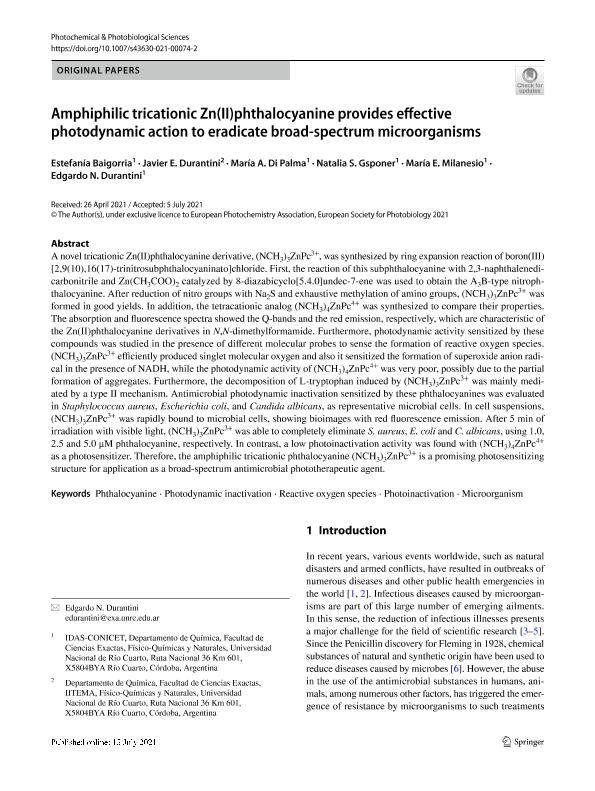Artículo
Amphiphilic tricationic Zn(II)phthalocyanine provides effective photodynamic action to eradicate broad-spectrum microorganisms
Baigorria, Estefanía ; Durantini, Javier Esteban
; Durantini, Javier Esteban ; Di Palma, María Albana
; Di Palma, María Albana ; Gsponer, Natalia Soledad
; Gsponer, Natalia Soledad ; Milanesio, María Elisa
; Milanesio, María Elisa ; Durantini, Edgardo Néstor
; Durantini, Edgardo Néstor
 ; Durantini, Javier Esteban
; Durantini, Javier Esteban ; Di Palma, María Albana
; Di Palma, María Albana ; Gsponer, Natalia Soledad
; Gsponer, Natalia Soledad ; Milanesio, María Elisa
; Milanesio, María Elisa ; Durantini, Edgardo Néstor
; Durantini, Edgardo Néstor
Fecha de publicación:
07/2021
Editorial:
Royal Society of Chemistry
Revista:
Photochemical and Photobiological Sciences
ISSN:
1474-905X
Idioma:
Inglés
Tipo de recurso:
Artículo publicado
Clasificación temática:
Resumen
A novel tricationic Zn(II)phthalocyanine derivative, (NCH3)3ZnPc3+, was synthesized by ring expansion reaction of boron(III) [2,9(10),16(17)-trinitrosubphthalocyaninato]chloride. First, the reaction of this subphthalocyanine with 2,3-naphthalenedicarbonitrile and Zn(CH3COO)2 catalyzed by 8-diazabicyclo[5.4.0]undec-7-ene was used to obtain the A3B-type nitrophthalocyanine. After reduction of nitro groups with Na2S and exhaustive methylation of amino groups, (NCH3)3ZnPc3+ was formed in good yields. In addition, the tetracationic analog (NCH3)4ZnPc4+ was synthesized to compare their properties. The absorption and fluorescence spectra showed the Q-bands and the red emission, respectively, which are characteristic of the Zn(II)phthalocyanine derivatives in N,N-dimethylformamide. Furthermore, photodynamic activity sensitized by these compounds was studied in the presence of different molecular probes to sense the formation of reactive oxygen species. (NCH3)3ZnPc3+ efficiently produced singlet molecular oxygen and also it sensitized the formation of superoxide anion radical in the presence of NADH, while the photodynamic activity of (NCH3)4ZnPc4+ was very poor, possibly due to the partial formation of aggregates. Furthermore, the decomposition of L-tryptophan induced by (NCH3)3ZnPc3+ was mainly mediated by a type II mechanism. Antimicrobial photodynamic inactivation sensitized by these phthalocyanines was evaluated in Staphylococcus aureus, Escherichia coli, and Candida albicans, as representative microbial cells. In cell suspensions, (NCH3)3ZnPc3+ was rapidly bound to microbial cells, showing bioimages with red fluorescence emission. After 5 min of irradiation with visible light, (NCH3)3ZnPc3+ was able to completely eliminate S. aureus, E. coli and C. albicans, using 1.0, 2.5 and 5.0 μM phthalocyanine, respectively. In contrast, a low photoinactivation activity was found with (NCH3)4ZnPc4+ as a photosensitizer. Therefore, the amphiphilic tricationic phthalocyanine (NCH3)3ZnPc3+ is a promising photosensitizing structure for application as a broad-spectrum antimicrobial phototherapeutic agent.
Archivos asociados
Licencia
Identificadores
Colecciones
Articulos (IITEMA)
Articulos de INSTITUTO DE INVESTIGACIONES EN TECNOLOGIAS ENERGETICAS Y MATERIALES AVANZADOS
Articulos de INSTITUTO DE INVESTIGACIONES EN TECNOLOGIAS ENERGETICAS Y MATERIALES AVANZADOS
Articulos(INTEMA)
Articulos de INST.DE INV.EN CIENCIA Y TECNOL.MATERIALES (I)
Articulos de INST.DE INV.EN CIENCIA Y TECNOL.MATERIALES (I)
Citación
Baigorria, Estefanía; Durantini, Javier Esteban; Di Palma, María Albana; Gsponer, Natalia Soledad; Milanesio, María Elisa; et al.; Amphiphilic tricationic Zn(II)phthalocyanine provides effective photodynamic action to eradicate broad-spectrum microorganisms; Royal Society of Chemistry; Photochemical and Photobiological Sciences; 20; 7-2021; 939–953
Compartir
Altmétricas



